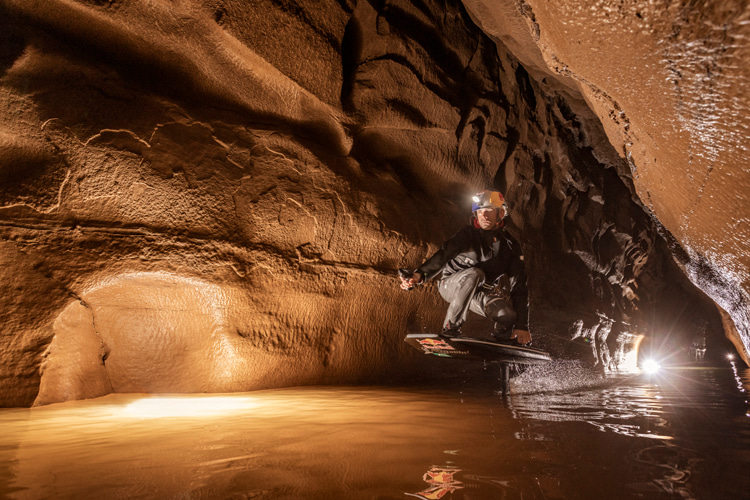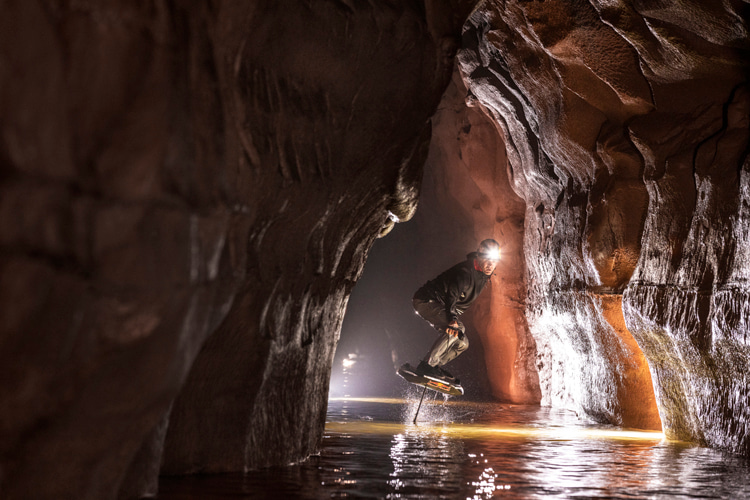Deep within the pitch-black depths of Bluespring Caverns in Bedford, Indiana, two-time world wakeskating champion Brian Grubb initiated an unprecedented venture.
Submerged an incredible 98 feet (30 meters) beneath the surface, he readied himself for a groundbreaking exploit - the world's first underground e-foil expedition.
Guided by the spectral luminescence of LED lights fastened to his e-foil, Grubb coursed through the aquatic topography.
He traversed a remarkable 21 miles (34 kilometers) along the Myst'ry River, acknowledged as America's most extensive subterranean navigable watercourse.
Grubb was magnetically drawn to the challenge of navigating Myst'ry River, a dark, echoing pathway that holds the title of America's longest navigable underground river.
The first images of this subterranean splendor that reached Grubb revealed an opportunity he simply couldn't ignore.
"I had this gut instinct that wakeskating could thrive in these subterranean waters," Grubb revealed.
"But when we scouted out the location, it dawned on me that the e-foil could create an even more gripping spectacle."
"Taking into account the delicate environment and the cave's tight quarters, a zero-emissions electric e-foil appeared far more suitable and exciting than a conventional gas winch."

Underground e-Foiling
With that innovative leap, Grubb introduced a whole new realm of extreme sport: underground e-foiling.
Propelling down the Myst'ry River, a river tucked 100 feet below the Earth's crust, Grubb's experience was a groundbreaking fusion of adventure, technological prowess, and breathtaking natural spectacle.
Inside the cave, a world where temperatures hover around a consistent 53 °F (11 °C), Grubb undertook exhaustive preparations.
Prior to the main event, he assessed the river path's water depth, cave width, and potential obstacles via a thorough kayak tour.
"A kayak gives you a sense of ample space, but hop on an e-foil and dart through at 20 miles per hour [32 kilometers per hour], and suddenly, things become a lot more narrow," added Grubb.
"This not only enhanced the thrill factor but also dialed up the technical demands of the ride."
Grubb's judicious planning managed to secure a water depth of five to six feet for his e-foil journey, which requires at least four feet to function.
Complex Logistics
Nevertheless, the journey wasn't without its fair share of hurdles.
"The logistics were demanding," Grubb admits.
"The 400-foot [120 meters] descent to the river, the absence of natural light, the complex cave acoustics, and the challenges of transporting and installing cameras and lighting gear - it was a Herculean task."
But Grubb and his dedicated team were relentless.
Operating out of boats and kayaks, they worked tirelessly, turning the nocturnal hours into a frenzy of planning, shooting, and adjusting to capture the perfect shots.
For Grubb, a pioneering spirit, such hurdles are the very essence of the adventure.
Having been instrumental in shaping the young, five-year-old realm of e-foiling, he's intimately involved in its growth - from the nitty-gritty of board design to pushing the boundaries of battery performance.
"As we engage more with water, we learn to perceive it in new ways. Wakeskating began with the concept of skating without boots, and e-foiling evolved from its surf roots into a mainstream water sport," Grubb explains.
The exhilarating ride through the Myst'ry River's narrow confines was a stimulating trial for the e-foil, and Grubb is thrilled by the boundless opportunities this presents.
"I'm driven by the quest for new adventures and experiences on the water," Grubb shares.
"This path of innovation and exploration is in my blood."
"Reflecting on our journey, it's mind-boggling to see how we've taken simple ideas and transformed them into influential sports, broadening the reach and joy of water sports to a wider audience."
